The harsh beauty can be soothing after the crassness and thrust of the city.

Mapungubwe National Park in Limpopo. Picture: iStock
Even in places like Europe, where history is right around every corner, it is not easy to imagine, standing outside a towering cathedral, what life must have been like for the occupants of the city in, say, the 1700s – because there’s a McDonald’s joint on the corner.
In a comparatively young (in written history terms, that is) country like ours, the new buildings in our cities can tend to crowd your vision so that it’s impossible to think what life may have been like in a particular spot hundreds of years ago.
That’s why, if you are fascinated with the human history to southern Africa, there are two sites you must visit – Great Zimbabwe and our own Mapungubwe in Limpopo. There has been much controversy about both as historians interpreted them through first colonial eyes, and then through the prism of proud African nationalism.
What is now not in dispute is that, around 1,000 years ago, both places were the site of thriving trading cities, with ivory and gold moving one way and artefacts including jewellery moving the other.

Picture: iStock
Mapungubwe, which sits near the confluence of the Limpopo and Shashi rivers and where three countries – South Africa, Botswana and Zimbabwe – meet, was more than just an exporter of resources, though, and apparently had its own highly developed goldsmith industry. This is evidenced by a large gold rhino, now the property, once again, of the people of South Africa.
In the rugged sandstone outcrops of the Limpopo Valley, all around Mapungubwe, is evidence of an even older civilisation. Rock art dating back as far as 3,000 years is in evidence everywhere … the area is one of the highest such concentrations of this art and, because of this and the presence of the city itself, the area has been proclaimed a World Heritage Site.
As you wind your way up a cleft between the rocks up the plateau atop the Mapungubwe massif, you can almost feel the past around you. There are no new buildings. There are no cars. There are no roads.
There is the heat of the valley. There is the whispering of the breeze and the buzzing of insects. Nothing to get in the way of your imagination populating the landscape with people, huts, busy commerce …

Picture: iStock
Mapungubwe today is the heart of a SA National Parks reserve and you can get excellent guides to help you take in the history. Other private guides in the area can take you to the outstanding rock art sites both inside and outside the park.
But, Mapungubwe wouldn’t be a SANParks destination if it didn’t have the traditional wildlife attractions. It has a range of antelope, including eland, wildebeest, bushbuck, duiker and red hartebeest, although the latter is rare, according to the guide book.
Elephants are common and you’re virtually guaranteed to see one. One took us by surprise on our first visit to the park, about eight years ago, when we were meandering along the 4×4 route.
I got out (naughty, naughty) to take a photo of the car passing under an overhanging bough in the riverine forest on the banks of the Limpopo. I heard a swish not more than 50 metres away and glimpsed a hulking grey shape … and sprinted back to the car.

Picture: iStock
Giraffes are also common sightings, along with warthogs. They say that, if you’re lucky, you may see predators like lion, leopard, cheetah or even wild dog. That’s because, not being fully fenced, the park is accessible to animals wandering around from the three adjacent countries.
Mapungubwe is more the place for bird watchers and we have been rewarded with some memorable experiences, including seeing a pearl-spotted owl mid-morning close to the bird hide by the river and a pair of black eagles nesting at the Leokwe rest camp.
Mapungubwe is still, pretty much, a wild place. And the harsh beauty can be soothing after the crassness and thrust of the city, which seems to squeeze out everything else.
- For more details, go to www.sanparks.org
For more news your way, download The Citizen’s app for iOS and Android.





